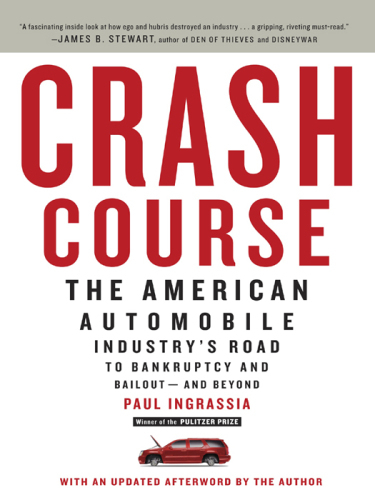
Crash Course
The American Automobile Industry's Road from Glory to Disaster
کتاب های مرتبط
- اطلاعات
- نقد و بررسی
- دیدگاه کاربران
نقد و بررسی

January 4, 2010
Pulitizer-prize winning journalist Ingrassia offers a timely look at the dramatic history of the auto industry in the wake of the meltdown of General Motors, Ford, and Chrysler-America's Big Three car companies. Ingrassia, former Detroit bureau chief for the Wall Street Journal, brings enviable first hand knowledge and perspective to this fast paced narrative, which spans more than a century of volatility-while Americans have conducted an on-going love affair with the car, our leading auto companies have been on the brink of collapse countless times. Beginning with Henry Ford's early years, onto Alfred P. Sloan's mass marketing genius and on to the formation of the UAW in 1935, the author chronicles how the Big Three came to dominate the marketplace. From the post-war boom years to the style driven, fin-laden muscle cars in the 50s and 60, Ingrassia traces the mushrooming mismanagement, hubris, safety issues, union struggles, and failure to innovate which threatened the industry. From the 1970s, with the entrance of foreign cars, to the rise of the SUV and numerous mergers of the 1990s, we are led through the industry's rollercoaster ride, lurching toward what seems, in retrospect, the inevitable crash. A fascinating, superbly crafted, and entertaining read.

Starred review from November 15, 2009
A Pulitzer Prize–winning journalist's pedal-to-the-metal history of America's signature industry.
In the mid 1920s, Henry Ford, mass production's inventor, outsold all competitors combined. General Motors CEO Alfred Sloan pioneered mass marketing—"a car for every purse and purpose"—and hired the auto industry's first design staff. Walter Chrysler was Time Man of the Year in 1928. By 2009 both GM and Chrysler had entered bankruptcy and Ford only barely escaped. American car companies had sunk to a state best summarized by The Economist headline,"Detroitosaurus Wrecks." Former Wall Street Journal Detroit bureau chief Ingrassia (co-author: Comeback: The Fall& Rise of the American Automobile Industry, 1994) conducts a brilliant industry autopsy, tracing the decline to the'70s—though Ralph Nader exposed Detroit's shoddy products as early 1965—when the combination of complacent, arrogant management, increasingly mindless union militancy and surprisingly nimble foreign competition began to threaten America's worldwide leadership. Though the Big Three mounted a comeback of sorts during the'80s and'90s, the industry soon fell back into the bad habits that led to the current meltdown. A delightful mix of history and first-person reporting, Ingrassia's narrative covers numerous historic episodes, including the United Auto Workers' storied Battle of the Overpass, the introduction of the Corvette and the Thunderbird, the birth of Volkswagen and the rise of Toyota, the Ford Pinto that exploded and the Edsel that laid an egg, GM's failed Saturn experiment, the doomed DaimlerChrysler marriage and the government's bailout negotiations with GM and Chrysler. The tales of bit players like the South Paris, Maine, Chrysler dealer Gene Benner and the father-son UAW members Fred and Gene Young of Belvidere, Ill., are effectively set against the machinations of management big shots like Billy Durant, Lee Iacocca and Richard Wagoner and labor honchos Walter Reuther, Leonard Woodcock and Stephen Yokich.
Employing superb storytelling skills, Ingrassia explains in head-shaking detail the elements of a wholly avoidable collision.
(COPYRIGHT (2009) KIRKUS REVIEWS/NIELSEN BUSINESS MEDIA, INC. ALL RIGHTS RESERVED.)

























دیدگاه کاربران